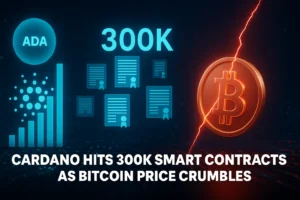Cardano Hits Record 115M Transactions, Celebrates 8 Years of Steady Uptime, Usage

Cardano’s mainnet crossed 115,000,000 on-chain transactions this week, a round-number milestone that arrived without fireworks yet speaks clearly about utility. Community watchers flagged the count, then confirmed across crypto desks, framing an eight-year story of uptime and steady usage rather than trading theatrics.
- Eight Years Live, and Why Reliability Matters
- The Delegation Flywheel: Staking that Looks and Feels Like DPoS
- Governance Moves from Convention to a Constitution
- Leios: Throughput Targets with Guardrails
- Hydra: From Lab to Live Experiments
- What the Data Says: Usage, TVL, and Context
- ETF Backdrop: Pathways Open, Timing Still a Variable
- Market and Investor Angle: Reading the Milestone
- Cardano Signals at a Glance
- Conclusion
- Frequently Asked Questions About Cardano Hits 115M Transactions
- How significant is the 115M transaction milestone?
- What are Leios and Hydra, in practical terms?
- What changed in governance this year?
- How healthy is staking participation right now?
- Could an ADA ETF arrive soon?
Cardano’s operational cadence is built on its Delegated Proof of Stake (DPoS) mechanism. This participation design allows holders to delegate their stake to professional pools, a structure that keeps custody with the user while broadening participation.
This model effectively turns what might be long-only holders into active contributors to both block production and network governance, reinforcing the system’s security and decentralized operation.
The milestone lands alongside governance that has moved from convention to a ratified Constitution, and a scaling roadmap that splits near-term experimentation and mid-term throughput expansion between Hydra and Leios. For investors, the throughline is simple: Cardano is shipping the slow, boring parts that make fast parts possible later.
ALSO READ: 21Shares Amends Sui Staking ETF for Nasdaq, Market Responds with a 2.5% Surge
Cardano surpassed 115 million transactions on October 23, 2025, with multiple outlets echoing the figure and crediting community trackers for the initial call-out. U.Today summarized the significance in plain terms, putting “resilience and adoption” at the center of the story. The number is a cumulative indicator, not a one-day spike, and it arrives after nearly eight years of continuous operation.
A widely followed Cardano account on X, @Cardanians_io, condensed the moment. “Another major milestone for Cardano #ADA, Cardano processed over 115 million transactions on mainnet.” That post set the tone for market commentary that followed. Short, factual, and focused on use.
Another major milestone for Cardano $ADA.
Cardano processed over 115 million transactions on mainnet.
It’s here for your 24/7 for 8+ years. https://t.co/uaHurmQR0U
— Cardanians (CRDN) (@Cardanians_io) October 23, 2025
Investors should treat the milestone as an operating metric. Fees were paid, blocks finalized, and applications kept transacting, which is the fundamental story for any base layer that aspires to be infrastructure, not a headline generator.
Eight Years Live, and Why Reliability Matters
The network’s longevity underwrites the milestone’s importance. U.Today placed the 115M count inside an “eight years of existence” frame, a reminder that Cardano’s uptime and predictable finality are part of its brand. Reliability reduces variance for developers, which in turn supports user habits that add up to big numbers over time.
In public chains, reliability is a moat. It lowers the cost of building, it keeps integration partners comfortable, and it encourages holders to delegate stake without second-guessing the rails underneath. The result is a steady accrual of transactions that do something for someone every day, even when prices chop sideways.
The Delegation Flywheel: Staking that Looks and Feels Like DPoS
Cardano’s participation model relies on Delegated Proof of Stake (DPoS). Holders point their ADA to a pool while retaining custody of their keys and earning rewards based on the pool’s performance. This user-friendly method boosts validator participation and mirrors the benefits of DPoS: professional operators handle the day-to-day block production, but ultimate power remains with the delegators.
The macro picture supports the thesis. Messari’s State of Cardano Q2 2025 shows a staking rate near 60.1% of eligible supply, even as other metrics softened during the quarter. That steadiness explains how on-chain counts can keep rising through cycles. Delegation anchors participation, which stabilizes throughput, which encourages investors, which brings activity. A milestone like 115M is the visible part of that loop.
ALSO READ: XDC Network Unveils $10M “Surge”, Brings Real-Time Transparency to DeFi
Governance Moves from Convention to a Constitution
The governance overhaul is not a proposal; it is ratified. Intersect and IOG describe a Constitution that now powers on-chain governance, with a Constitutional Committee that certifies actions as constitutional, and DReps who act as the community’s voting voice. After the Plomin upgrade in early 2025, the framework became fully operational, giving stakeholders process clarity for budgets and upgrades.
Why it matters to investors: predictability lowers tail risk. With codified checks, the system can evolve without governance drama, and stake-delegated participation scales voting without forcing users to become full-time politicians. It is the governance complement to DPoS-style practicality, anchored in Cardano’s own vocabulary and structures.
Leios: Throughput Targets with Guardrails
Leios is the next big swing at throughput. Essential Cardano places the goal at 30 to 65 times the current Praos capacity, using additional secondary blocks that a committee validates before inclusion, while standard blocks continue as usual. It is an architectural change that tries to multiply capacity without breaking the economic logic of Ouroboros.
Public explainers and partner briefs echo those targets, and they describe a development model that hands work across global teams to accelerate delivery. The aim is not a marketing number; it is headroom for applications that need sustained throughput. If Cardano wants more real-time finance and consumer-grade UX, Leios is the place where the base layer stretches to meet them.
Hydra: From Lab to Live Experiments
Hydra has moved from whiteboard to field test. The Hydra Node 1.0.0 release enables developers to deploy Hydra Heads that settle back to the mainnet, allowing live experimentation with real ADA. Cexplorer’s technical note calls it a pre-release with mainnet deployment enabled, which is the practical line investors should note. Proof of concept is becoming measured practice.
Hydra’s promise is simple: shift bursts of activity into off-chain heads, resolve conflicts there, and settle the results to the base chain without clogging it. It is a conservative path that keeps the core chain predictable, while giving builders a place to chase high-volume scenarios. The combination with Leios, if both deliver, is a two-layer strategy for capacity.
What the Data Says: Usage, TVL, and Context
Quarterly snapshots show the lumpy side of adoption. Messari recorded declines in average daily transactions and fees in Q2, along with price underperformance against a stronger Layer-1 cohort. At the same time, the staking rate held near 60%, preserving the delegation flywheel that long-only allocators value. That context helps explain why the 115M marker matters; it sits atop a broad, engaged base.

DeFi metrics underscore the work ahead. DefiLlama’s Cardano dashboard shows modest TVL and volumes relative to Ethereum and Solana, but a stable community that continues to build and transact. For capital allocators, the picture is a mix of steady base-layer use and a DeFi stack that is still finding its scale. It is a useful, if unspectacular, setup for compounding.
ETF Backdrop: Pathways Open, Timing Still a Variable
Regulatory news set a friendlier stage in September when the SEC approved generic listing standards for spot commodity ETFs, a change that shortens approval paths for digital-asset products beyond Bitcoin and Ether. That backdrop matters for ADA, even if a dedicated product remains a timing question rather than a near-dated catalyst. Treat it as optionality, not a base case.
ETF optimism should not overshadow the operating story. A network that logs 115M transactions, formalizes governance, and advances scaling already has a thesis. If a single-asset or basket ETF later adds flows, that is additive to an arc that exists without it.
Market and Investor Angle: Reading the Milestone
Markets tend to overprice fast catalysts and underprice slow compounding. Cardano’s latest count belongs in the second category. The number confirms use, the governance layer assures process, and the scaling roadmap targets capacity. For portfolio construction, treat ADA as core exposure to a conservative Layer-1 with DPoS-style delegation mechanics, and size it to volatility tolerance. Use milestones like 115M as checkpoints rather than triggers.
A simple discipline works here. Track monthly active addresses, staking participation, and throughput notes from Leios and Hydra, then map allocation to those data rather than to headlines. If governance continues to execute and capacity expands, transaction counts should keep climbing, and the base case for holding should strengthen.
Cardano Signals at a Glance
| Signal | Latest context | Why investors care |
| On-chain transactions | 115,000,000+ as of Oct 23, 2025 | Confirms durable, routine usage. |
| Staking rate | ~60.1% of the eligible supply | Broad, delegation-driven participation supports security. |
| Governance status | Constitution ratified, committee and DReps live | Predictable process for upgrades and budgets. |
| Scaling, near term | Hydra Node 1.0.0 mainnet-enabled testing | Field experiments without base-layer disruption. |
| Scaling, mid-term | Leios targets 30–65× throughput | Capacity headroom for real-time apps. |
| DeFi snapshot | Modest TVL and volumes | Room to grow as capacity and liquidity build. |
| ETF environment | Generic spot ETF standards approved | Optional upside for flows, timing uncertain. |
Conclusion
Cardano’s 115,000,000 transaction print is the kind of headline that matters, an operating result that validates a methodical approach to security, governance, and scale. Delegated Proof of Stake (DPoS) maintains broad participation for users while ensuring they retain full sovereignty over their keys. Furthermore, governance is codified through a ratified Constitution and a live committee structure, which eliminates guesswork regarding network upgrades and budget allocation.
Scaling is advancing on two fronts: Hydra for live experiments and Leios for structural throughput gains. If ETFs join the story later, so be it; the base case does not depend on them. The count itself tells you what you need to know: people are using the network, every day, in enough volume to make a round number feel earned.
Frequently Asked Questions About Cardano Hits 115M Transactions
How significant is the 115M transaction milestone?
It is a clean operating metric that signals sustained, real usage after eight years of live service. It matters because it reflects habits, not hype, and it is verified by independent coverage.
What are Leios and Hydra, in practical terms?
Leios is a protocol upgrade that aims to multiply throughput 30–65× by adding committee-validated secondary blocks. Hydra enables off-chain heads that settle to mainnet, allowing live, high-volume experiments without stressing the base layer.
What changed in governance this year?
Cardano moved from convention to a ratified Constitution, with a Constitutional Committee and DReps that formalize on-chain voting and reviews. The framework went live with the Plomin upgrade in early 2025.
How healthy is staking participation right now?
Messari places the staking rate near 60.1% of the eligible supply in Q2 2025. That steadiness supports security and aligns incentives for holders, pools, and developers.
Could an ADA ETF arrive soon?
The SEC approved generic listing standards for spot commodity ETFs, opening faster pathways for digital-asset products. An ADA-specific timeline remains a variable, so consider it optional upside rather than a base-case driver.




